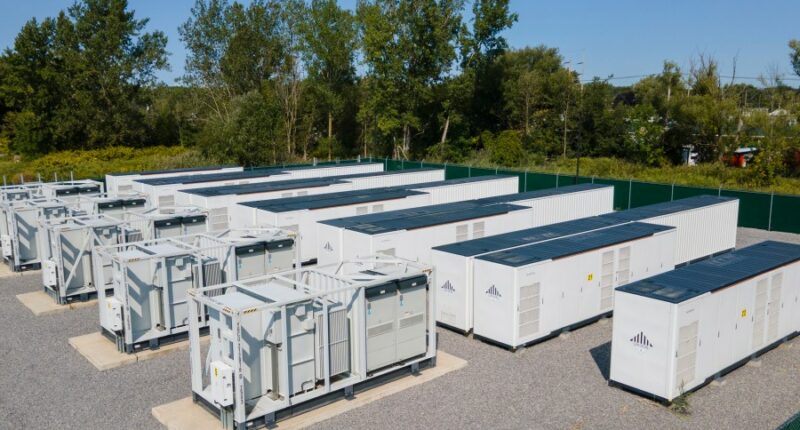Share this @internewscast.com

Increasingly, extensive arrays of lithium-ion batteries are being connected to electrical grids across the U.S. to store energy that can be released during periods of high demand.
However, as more energy storage is introduced, residents in some areas have become concerned, fearing potential fires, similar to what happened at a large facility in California earlier this year.
Proponents maintain that state-of-the-art battery energy storage systems are safe, but more localities are enacting moratoriums.
“We’re not guinea pigs for anybody … we are not going to experiment, we’re not going to take risk,” stated Michael McGinty, the mayor of Island Park, New York, which enacted a moratorium in July following a proposal for a storage system near the village boundary.
At least a few dozen localities around the United States have moved to temporarily block development of big battery systems in recent years.
On Long Island, where the power grid could benefit from upcoming offshore wind farms, activism has been fervent, drawing national attention, even from the Trump administration. In August, Environmental Protection Agency Administrator Lee Zeldin visited New York, criticizing the state for hastily approving sites to meet what he called “delusional” green energy targets — a claim refuted by state officials.
Battery growth spurt
Battery energy storage systems, which absorb inexpensive power during low demand and release it at a profit during high demand, are deemed vital with the growth of intermittent energy sources like wind and solar.
Referred to as BESS, these systems can enhance grid reliability and have been recognized for decreasing blackouts. A significant battery system might include rows of shipping containers arranged in a secured lot, each container housing a vast number of cells.
China and the United States lead the world in rapidly adding battery storage energy systems. However, Saudi Arabia, South Africa, Australia, Netherlands, Chile, Canada and the U.K. have commissioned or started construction on large projects since 2024, too, according to research from BloombergNEF.
In the U.S., California and Texas have been leaders in battery storage. But other states are moving quickly, often with privately developed systems. While the Trump administration has been unsupportive or even hostile to renewable energy, key tax credits for energy storage projects were maintained in the recently approved federal budget for qualified projects that begin construction in the next eight years.
Developers added 4,908 megawatts of battery storage capacity in the second quarter of 2025, with Arizona, California and Texas accounting for about three-quarters of that new capacity, according to a report from American Clean Power Association, an industry group. That’s enough to power nearly 1.7 million households.
New York has an ambitious goal to add 6,000 megawatts of energy storage by 2030, half of it large-scale systems.
Lithium-ion fire worries
Opposition to the storage systems usually focuses on the possibility of thermal runaway, a chain reaction of uncontrolled heating that can lead to fire or an explosion. Opponents point to past fires and ask: What if that happens in my neighborhood?
A battery storage system in Moss Landing, California caught fire in January, sending plumes of toxic smoke into the atmosphere and forcing the evacuation of about 1,500 people..
Experts in the field say battery systems have become safer over the years. Ofodike Ezekoye, a combustion expert and professor of mechanical engineering at The University of Texas at Austin, notes that failures are relatively infrequent, but also that no engineered system is 100% foolproof.
“This is a relatively immature technology that is maturing quickly, so I think that there are a lot of really thoughtful researchers and other stakeholders who are trying to improve the overall safety of these systems,” Ezekoye said.
Battery storage proponents say a facility like Moss Landing, where batteries were stored indoors, would not be allowed in New York, which has adopted fire codes that require modular enclosure design with required minimum spacing to keep fires from spreading.
Blocking battery systems
People who live near proposed sites are not always assured.
In Washington state, the city of Maple Valley approved a six-month moratorium in July as a way “to protect us until we know more,” said city manager Laura Philpot.
Voters in Halstead, Kansas, which has a moratorium, will be asked this Election Day whether they want to prohibit larger battery storage systems inside the city limits, according to Mayor Dennis Travis. He hopes the city can one day host a safely designed storage system, and said local opponents wrongly fixate on the California fire.
The number of localities passing moratoriums began rising in 2023 and 2024, mirroring trends in battery storage deployment, with a notable cluster in New York, according to a presentation last year by the Pacific Northwest National Laboratory.
Winnie Sokolowski is among area residents against a proposed 250-megawatt lithium-ion storage system in the Town of Ulster, New York, contending it is too close to schools and homes.
“They’re banking on nothing happening, but I don’t think you can place it where they’re proposing and assume nothing’s going to happen,” Sokolowski said. “It’s just too risky if it does.”
The developer, Terra-Gen, said the design will keep a fire from spreading and that the system “poses no credible, scientific-based threat to neighbors, the public or the environment.”
New York State Energy Research and Development Authority President Doreen Harris said she’s confident the state has the right safety rules in place, and that scaling up the use of battery storage systems will “strengthen and modernize our grid.”
She noted there also were local concerns in the early stages of siting solar farms, which have since proven their benefits.
___
Associated Press writer Jennifer McDermott in Providence, Rhode Island, contributed to this report.
















